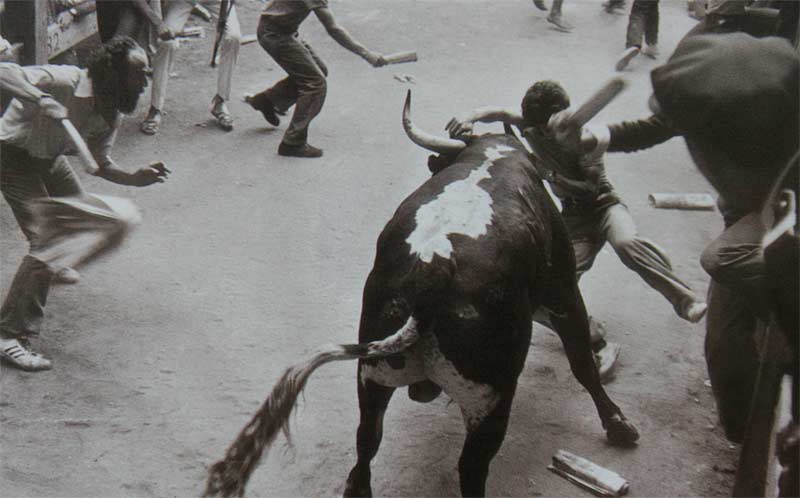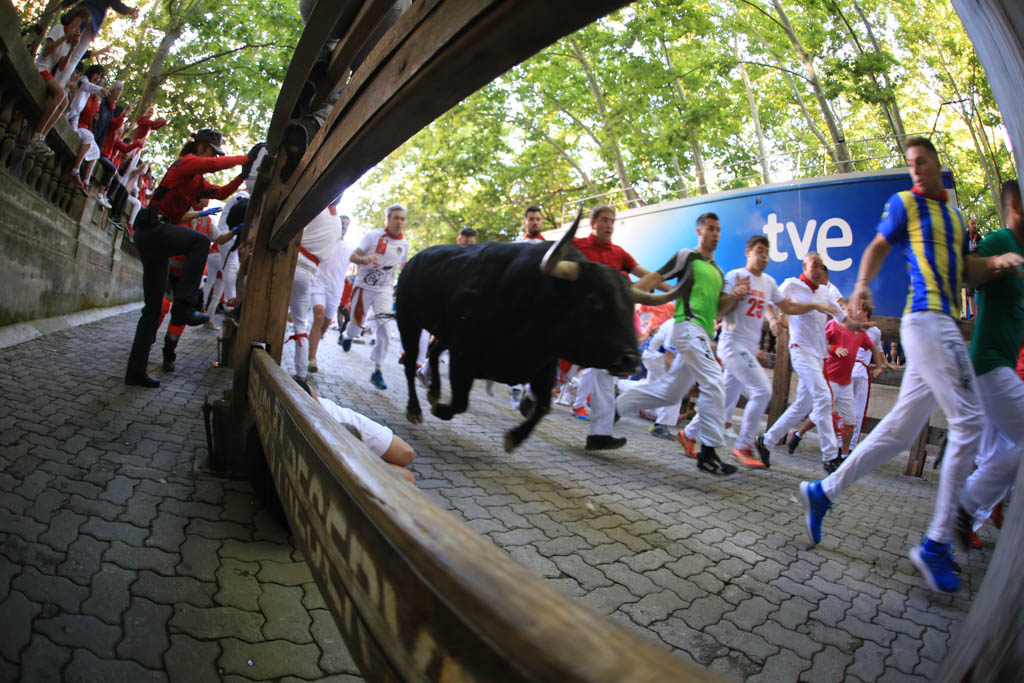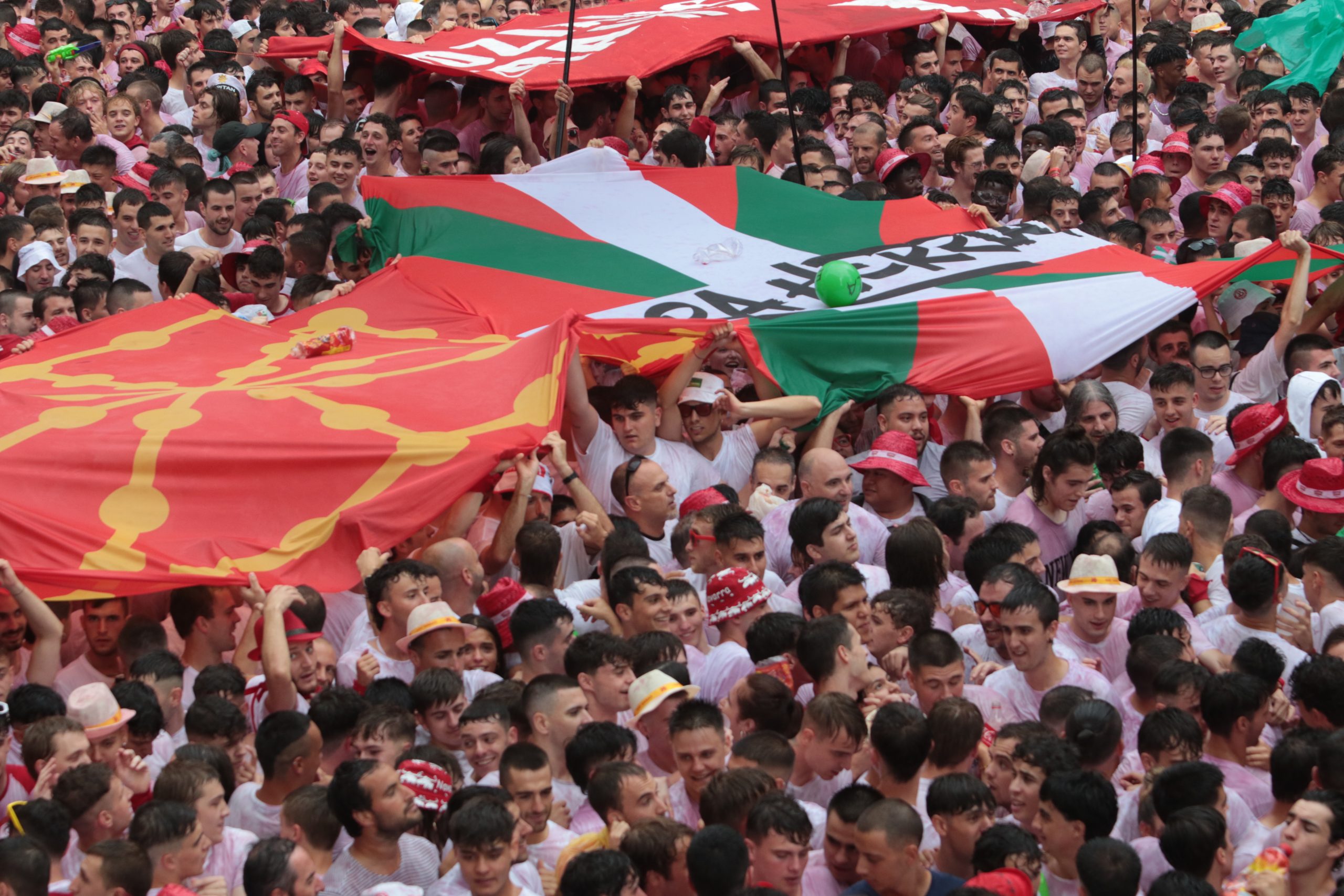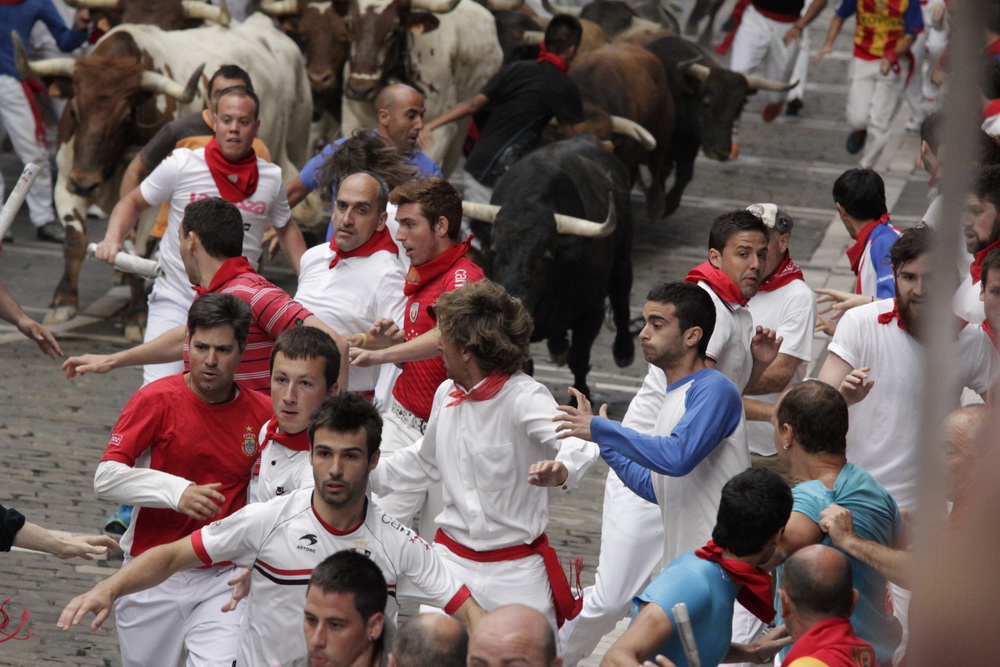Foto: © Zubieta y Retegui
Here are dates when the dangerous running of the bulls in Iruñea/Pamplona has met with tragic consequences.
2003. Fermín Etxeberria Irañeta. Pamplona
1995. Matthew Peter Tasio. Illinois (USA)
1980. Vicente Risco. Badajoz
1980. José Antonio Sánchez Navascués. Cintruénigo (Navarra)
1977. José Joaquín Esparza Sarasíbar. Pamplona
1975. Gregorio Górriz Sarasa. Arazuri (Navarra)
1974. Juan Ignacio Eraso Martiartu. Pamplona
1969. Hilario Pardo Simón. Murchante (Navarra)
1961. Vicente Urrizola Istúriz. Pamplona
1947. Casimiro Heredia. Pamplona
1947. Julián Zabalza. Villava
1935. Gonzalo Bustinduy. San Luis de Potosí (México)
1927. Santiago Martínez Zufia. Pamplona
1924. Esteban Domeño Laborra. Sangüesa
1910. Francisco García Gurrea. Falces (Navarra)
10th July, 2009. Daniel Jimeno Romero
(27 years old, Alcalá de Henares, Madrid)
Pierced in the area of his left collarbone at the Telefónica stretch.
A Jandilla bull with the name “Capuchino”
Daniel Jimeno died at a quarter to nine after receiving a fatal goring to his neck at the Telefónica stretch. The runner was admitted to hospital suffering from respiratory arrest and the medical team could do nothing to save his life.
From the very beginning “Capuchino” was eyeing the runners and the animal did not follow the course being taken by the other bulls and the bell-oxen. When the bulls entered the City Hall Square, the bull did not shape to turn left but rather charged straight ahead into several runners. It got left behind by the other animals and in Mercaderes it gored another runner. The bull covered the rest of the course alone.
As the rear bull, it caused a lot of frights along the length of the course and in Telefónica it did not follow the direct line and it charged into a group of runners on the right side of the fencing. Daniel Jimeno was on the ground and he tried to slip away under the fencing after falling on the ground. Capuchino charged into the group of runners and the bull caught the runner with his left horn and it pierced the collarbone in a downward trajectory. The intra-clavicle wound cut the cava vein and made him lose a lot of blood. He was taken to the Hospital de Navarra, but his wounds were mortal and irreparable.
8th July, 2003. Fermin Etxeberria Irañeta
(63 years old, Pamplona). He died the 24th of September of 2003.
Section of the run: Mercaderes
Ranch: Cebada Gago
Bull: “Castillero”
Fermin Etxeberria, a regular participant in the running of the bulls since he was fourteen years old, received a severe knock from one of the Cebada Gago bulls on the stretch of Mercaderes which produced a severe cranial traumatism. He was immediately taken off to hospital. Three days later he underwent an operation after suffering arterial hypertension.
From that time onwards he remained in the Intensive Care Unit of the Hospital de Navarra in a permanent coma and with artificial respiration until nearly the end of September, when he was removed to a ward. The 24th of September he died at the San Juan de Dios Clinic in Iruñea-Pamplona, after been in the hospital for two months and a half.
13th July, 1995. Matthew Peter Tasio
(22 years old, Illinois, USA)
Section: Plaza Consistorial
Ranch: Torrestrella
Bull: “Castellano”
Matthew Peter Tasio stopped off to make a quick visit to the Sanfermines while he was doing his European tour that fateful summer. He came into Pamplona late on the night of the 12th on the coach from Barcelona accompanied by a friend of his. The two young men met up with some compatriots and were soon caught up in the party atmosphere of the long nights of the Festival. Matthew decided he would take part in the bull-running the following morning before taking a coach away the following morning so as to continue their European itinerary.
That ominous morning the streets were packed with runners. At eight in the morning the rocket went off to indicate the release of the bulls from the pen at the bottom of Santo Domingo street. The bulls charged out at an unusually fast pace and caused various runners to scurry and slide as they stumbled to evade the oncoming pack of bulls. “Castellano” was the name of the leading bull and it was leading the charge into the square of the Town Hall. Matthew Tasio was among the scurrying runners in front of the bull.
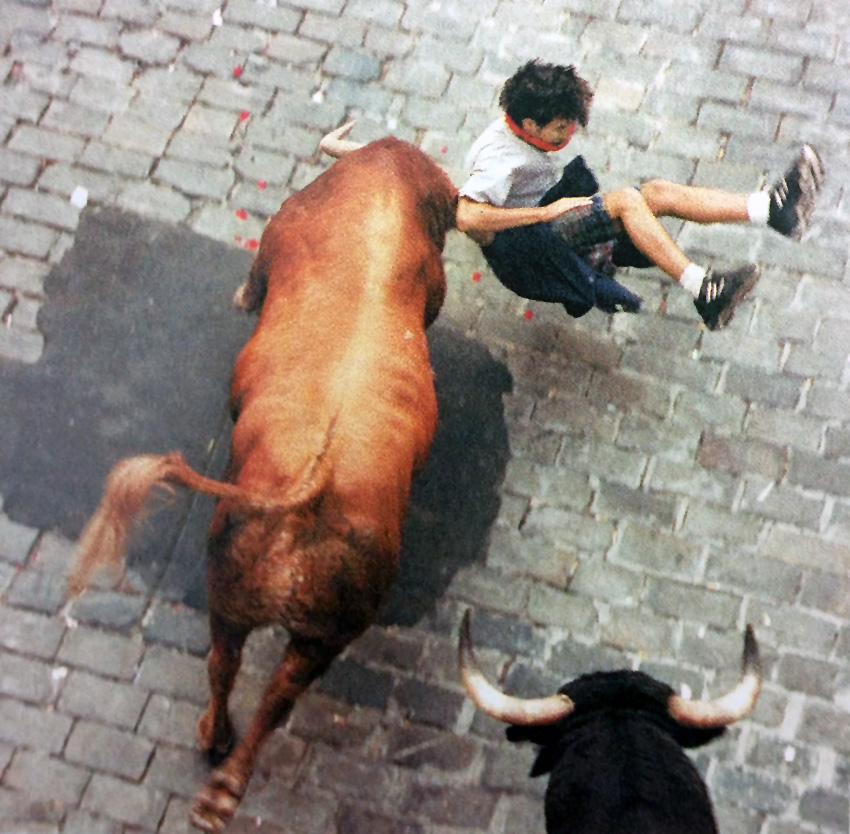
© Emilio Zazu
The young man slipped to the ground and struggled to get up again. But no sooner did he get to his feet than he fell once more as other runners dashed past. He began to lift himself once more to his feet when “Castellano” came charging up behind him and ripped into him with his terrible horns at full speed and with all the weight of its 575 kilograms. The goring was mortal from the first, the horns ripped into his stomach and cut through the aorta artery. The young man tried to crawl away to avoid the onrushing pack of bulls coming behind. He struggled as best he could towards the safety of the corral on the right, where a Red Cross unit was standing by. He was quickly rushed to hospital.
The goring had caused severe anemia and he lost 90% of his blood even before he reached the hospital. Eight minutes after the goring he was in the Hospital de Navarra – a remarkable fast time. But even so, he arrived unconscious and in a deplorable state. Despite the efforts made by the doctors to revive him, he passed away a few moments after his admission to the hospital.
13th July, 1980. Vicente Risco and José Antonio Sánchez Navascués
Ranch: Guardiola Fantoni
Bull: “Antioquio”
Vicente Risco
(29 years old, Badajoz)
Section: Bullring
José Antonio Sánchez Navascués
(26 years old, Cintruénigo, Navarra)
Section: Plaza del Ayuntamiento
One of the longest-lasting runnings in the whole history of the Sanfermines – it took 10minutes and 55 seconds and which resulted in the death of two runners, both of which were killed by the same bull, “Antioquio”. This was not the first time that the same bull had taken two lives in the same morning; 33 years earlier, “Semillero” had gored two runners to death on the fateful 10th of July, 1947.
On the deadly morning of the 13th of July, 1980 the whole length of the route was packed with runners and when the bulls were released from the pen they found a crowded mass of fleeing bodies in front of them. Once out of the pen the bulls charged in a pack up the slope of Santo Domingo street.
Just at the spot where the old Public Baths were to be found one of the bulls, “Antioquio” slipped and slid to the ground and got separated from the rest of the pack for the remainder of the run. Always an ominous augury in any of bull-runnings. The bull lifted itself and continued its charge forward although it was now a good distance behind the rest of the pack. Charging into the Town Hall square, just beside the Casa Seminario, the bull knocked one runner aside and charged straight at José Antonio Sánchez a young man running in front. It was a clean goring and the young man was dragged along by the horns for several meters almost to the entrance to Mercaderes.
A friend of the young man also running later related how he had shouted to José Antonio to watch out as the bull had turned dangerously towards the right side on getting to its feet, and this is always a dangerous sign, but within seconds he saw how his friend was gored and dragged along the street by the bull. Once tossed off by the bull, the First-Aid Unit rushed in and got the badly-wounded man quickly into an ambulance and rushed to the hospital. But despite giving a blood transfusion of more than 15 liters of blood, his heart stopped beating and the runner passed away at 10.30 in the morning.
“Antioquio”, who had continued its solitary run, came charging into the ring. It turned towards the right and charged towards a young man, Vicente Risco, and caught him on its horns. The bull tossed him off and the young man was left kneeling in the ring holding his shocked hands to his gored stomach from which blood was pouring profusely. The crowd roared in consternation and some runners rushed towards Vicente to help him away. But the bull had time to turn and charge again and gored him repeatedly before leaving him mortally wounded.
The bleeding runner was rushed away to the medical infirmary within the bull-ring, but to no avail. The severe goring meant that there was nothing the doctors could do to save him.
8th July, 1977. José Joaquín Esparza Sarasibar
(17 years old, Pamplona)
Section: callejón
Ranch: Eduardo Miura
Bull: “Silletero”
Text from the book “Historia trágica del encierro de Pamplona” (1978), by Luis del Campo
“A human blockade had formed right across the entrance. And it was caused by all those who don’t seem to have the guts to run in front of the bull’s horns and who start running pell-mell towards the ring practically before the rocket has gone off. The herd was confronted with a human wall blocking their way and the bulls, as if themselves terrified, struck out with their powerful horns and tried to clear a space through the crushing mass of bodies. The uproar was beyond description, the clamor deafening and the sensation astonishing.
The bulls turned about wildly, angry and excited. One of them, “Silletero” by name, who bore the number 12 on his back, the number branded onto his skin when he was a young bull, turned back towards the way he had come. Shouts and cries to close the wooden gate to the ring amid the general upheaval. Some felt that the bulls shouldn’t be allowed turn back and others thought that the bulls and piled-up bodies couldn’t be left like that in the narrow space of the entrance, all mixed together. Three times the main gate was opened and closed where two of the bulls and some of the bell-oxen come back out to the fences.”
It all happened in six minutes, but which seemed like an eternity, from the moment that the herd came up against the human wall of bodies until finally the rocket was heard with profound relief for it signified that the bulls had finally been led into the safety of their pens. The toll was one of the bloodiest ever in the long history of the bull-running, but for in most cases everyone recovered from their wounds without leaving any permanent traces. All except José Joaquin Esparza, a young man of 17 years, who was left dead on the spot”.
9th July, 1975. Gregorio Górriz Sarasa
(41 years old, Arazuri, Navarra)
Section of the run: callejón
Ranch: Francisco Javier Osborne (Jeréz de la Frontera – Cádiz)
Bull: “Navarrico”
Text from the book “Historia trágica del encierro de Pamplona” (1978), by Luis del Campo
“Meanwhile at the entrance to the ring there was another pile-up and instead of loosening, the pile-up grew tighter and tighter. The bell-oxen gingerly stepped over the sprawling bodies and entered the ring leaving many of the runners with bruises from their heavy hoofs. The bulls, seeing their passage blocked by the spread-eagled bodies, turned back and charged into everyone or anything in front of them.
The runners finally managed to turn the bulls and lead them towards the entrance. The bulls headed for the right side where the biggest pile-up was found. One of the bulls entered close to the side wall on the right before suddenly turning to its left. There he found Gregorio Gorriz and he charged at him and gave him a mortal goring“.
12th July, 1974. Juan Ignacio Eraso Martiartu
(18 years old, Txantrea, Pamplona)
Section of the run: between Telefónica and el callejón
Ranch: Herederos de Don Manuel Arranz (Salamanca)
Bull: “Palmello”
Text from the book “Historia trágica del encierro de Pamplona” (1978), by Luis del Campo
“Juan Ignacio Eraso had run the final stage of the bull-running from the end of Estafeta street, at the level of the Bar Fitero, He was aware of two bulls which had become separated from the others, but was unaware that there was a third bull further behind which had also become separated. After running almost to the entrance of the ring, and seeing the two bulls safely enter the ring, he decided to try to get up onto the fence. But the packed crowd meant that there was no free space and so he turned to walk back up the passageway.
Suddenly he found himself face to face with “Palmello” the remaining bull which he had not reckoned with. Despite the fact that other runners tried to distract it, Palmello had his sights set on Juan Ignacio Eraso, and the youth froze in his place, only covering his face with his arms, instead of trying to slip through the fence or attempt some other means of getting out of the way. He was gored against the right fence and lifted by the bull and tossed onto the left side of the fence”.
12th July, 1969. Hilario Pardo Simón
(45 years old, Murchante, Navarra)
Section: Santo Domingo
Ranch: Salvador Guardiola Fantoni
Bull: “Reprochado”
Text from the book “Historia trágica del encierro de Pamplona” (1978), by Luis del Campo
“The bull-run turned dangerous from the first moment as one of the bulls unexpectedly charged forward and outpaced the rest of the pack and was at the heels of the runners who were struggling to get away from it. Many of them pinned themselves against the long wall of the Military Hospital or, having lost their balance, lay stretched-out immobile on the pavement where they had fallen. Many of the runners turned to the right where there was some space available at the slope leading towards the Museum of Navarra.
“Reprochado” – for that was the name of the bull – followed those runners to the right and gored one, Gregorio Z.J., in the stomach with a tremendous butt of its horns. This runner would eventually recover from his wound, but a second runner was then immediately charged by the bull and this time it was a fatal charge for the runner had fallen to the ground – a man called Hilario Pardo- and he was caught in a fatal zig-zag attack where the bull swung first with his right horn and followed up with a blow from his left horn, which left the corpse gushing blood all over the pavement.
The subsequent photos revealed that the wounded man received the first goring and that the mortal victim was then attacked – contrary to what the crowd thought at the time where they thought the dead man had been attacked first”.
9th July, 1961. Vicente Urrizola Istúriz
(32 years old, Pamplona)
Section of the run: slope of Santo Domingo, beginning of Plaza Ayuntamiento
Ranch: Alvaro de Domecq
Text from the book “Historia trágica del encierro de Pamplona” (1978), by Luis del Campo
“Vicente Urrizola Isturiz was once more standing at the ready that morning at the initial stage of the bull-running as he was usually wont to do. He was at the level of the City Market building, in Santo Domingo street, just beside the Military Hospital (What is now the City Museum). The rocket went off and amid the rushing crowd, the mortal goring he received went unnoticed by the crowd and it was only when he died in hospital some thirty hours later from his wounds, that the full significance of the event was appreciated by the people of Pamplona”.
10th July, 1947. Casimiro Heredia
Pamplona
Section of the run: Estafeta
Ranch: Don Antonio Urquijo (Murubes)
Bull: “Semillero”
Text from the book “Historia trágica del encierro de Pamplona” (1978), by Luis del Campo
“Casimiro Heredia was standing inside the corral talking to some friends at the doorway of their house when the crowd came charging up the street leading the bulls. His last words to the couple were, ” You’d better get back inside…I’ll see you later. He ran for some yards in front of the bulls, unaware that one of the bulls, “Semillero”, had become separated from the others some distance back. We’ll never know if he was caught by surprise or if he had time to see the bull.
The fact is the bull was striding up the street, clearing space left and right, threatening all in front of him with his pointed horns. Casimiro was caught cleanly by the big horns and lifted by the bull from the middle of the street and tossed like a ragdoll to the right side of the pavement.
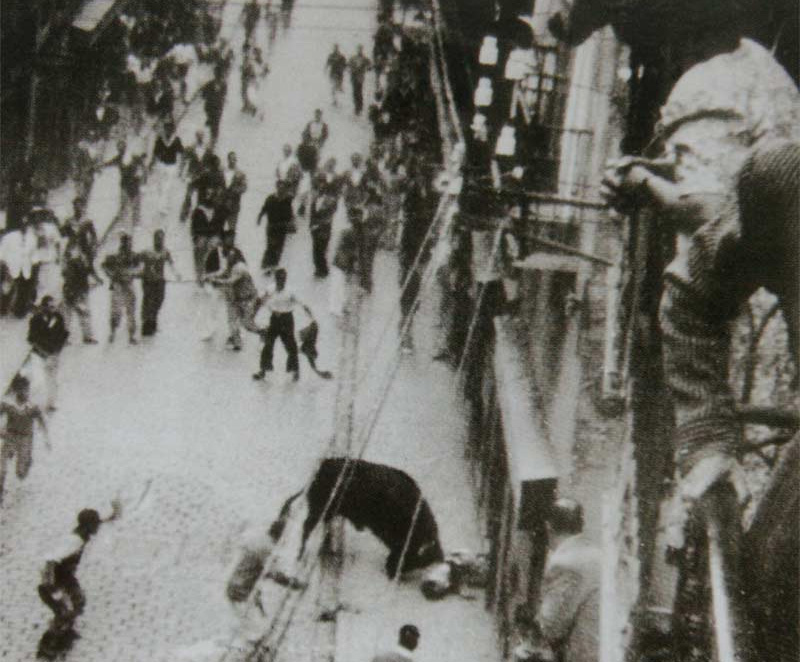
© Archivo Cecilio Vierge
The crowd immediately sensed the seriousness of the wound. The mortally wounded man was doubled up on the ground a few yards from the menacing bull when the bull noticed him again and once more charged into him. The bull lifted him up with his horns from the floor and tossed him against the wall of the street. The unfortunate man was already dead as the bull continued to toss him from side to side.”
10th July, 1947. Julián Zabalza
Villava (Navarra)
Section of the run: Bullring
Ranch: Don Antonio Urquijo (Murubes)
Bull: “Semillero”
Text from the book “Historia trágica del encierro de Pamplona” (1978), by Luis del Campo
“Meanwhile, the rampaging bull, furiously charged another runner who scurried to his right in an attempt to get under the protecting fence. Heedless of the danger, this runner – a young man from the nearby town of Villava – who had come to the bull-ring with his girlfriend and his sister – had decided to leave the safety of the ringside seats and go out through the entrance gate in search of the bull which had become separated from the others.
He ran back through the entrance gate followed by the bull and made the fatal mistake of turning towards the right side, which is invariably the side that the bulls always turn towards as they come through the entrance. Why this should be so is not very clear but if it is not a case where the bulls fan out and come through the entrance in formation, then it is almost inevitable that they will head towards the right side.
The runner tried to avoid the charge, but the bull found his target and ruthlessly gored the fleeing youth. While a couple of men – “El Chico de Olite” and “El Niño del Matadero” – successfully teased the bull away from the fallen body, a dismayed group hurried to the aid of the spread-eagled body in the arena. The bull was eventually lead to its pen while the mortally wounded youth was hurriedly carried to the surgery room within the bull-ring.
Within three or four minutes of his arrival, the young man, Julián Zabalza, expired from the fatal goring“.
10th July, 1935. Gonzalo Bustinduy y Gutiérrez de la Solana
29 years old, S. Luis de Potosí (México)
Section of the run: Bullring
Ranch: Doña Carmen de Federico (Murubes)
Text from the book “Historia trágica del encierro de Pamplona” (1978), by Luis del Campo
“The six bulls bred by Doña Carmen de Federico were just about to enter the final passageway leading to the ring when, suddenly, some reckless youths taunting the bulls caused the biggest of the pack to separate from the others as it turned back to confront the taunting youths. One of the youths boldly stepped in front of the bull waving his outstretched jacket in front of the bull’s face.
The young man had no idea of what he was doing – the very act of appalling risk would be enough to make that clear- if it had not been subsequently confirmed by many witnesses who related that the person had earlier been seen well out of his head from drinking even some hours before the bull-running started. The bull charged forward and the young man tried to effect a toreador’s cape with his jacket before falling to the ground.
The bull gored him with a mortal blow to the rips, tearing into him with a deep stab of his horns to his armpit. The gushing blood which quickly stained the bright yellow shirt of Gonzalo Bustinduy augured ill for his future and the worst fears of the onlookers were to be confirmed despite the bravery of the custodians and one “Chico de Olite” who teased the bull away from the mortally wounded man”.
8th July, 1927. Santiago Martínez Zufia
(34 years old, Pamplona)
Section of the run: Bullring
Ranch: Don Celso Cruz del Castillo (Toledo)
Text from the book “Historia trágica del encierro de Pamplona” (1978), by Luis del Campo
“The docile oxen were leading the bulls into the ring tamely and comfortably when, no sooner past the entrance, suddenly one of the bulls turned violently to the right away from the others, in pursuit of a man who was teasing him with a rod. The bull rushed towards one of the protective board fences at the side of the ring, in pursuit of his quarry, where, losing sight of his initial victim, he charged blindly at a man who happened to be in front of the wooden fence.
The bull gored Santiago Martinez, the unfortunate bystander, deeply and violently, lifting him up by the horns and only tossing him off when it bent its head to the ground, so deep was the goring. The hapless man struggled to his feet but only to fall mortally wounded into the arms of some men who had rushed to his aid”.
13th July, 1924. Esteban Domeño Laborra
(22 years old, Sangüesa)
Section of the run: Telefónica (before the callejón)
Ranch: Conde de Santa Coloma (Andalucía)
Text from the book “Historia trágica del encierro de Pamplona” (1978), by Luis del Campo
“And the crowd, oblivious to the fact that the safest spot is to head towards the left side of the corral when caught in a predicament, piled up on the right side where the bull only had to make a blind charge through them to butt and gore a victim. The unfortunate youth who was gored had no chance to avoid the headlong thrust of the bull as the tight crowd prevented him from jumping onto the fence and he was caught standing up with a clean mortal stab to his rigid body. It was clear from the first that the wound was serious as the youth dropped to the ground, rigid and intensely pale from the blow.”
Esteban Domeño Laborra was the name of the young man who was to die the following day at 1.30 in the afternoon of the 14th of July at the early age of 22, having only managed to survive the mortal goring for some 30 hours.
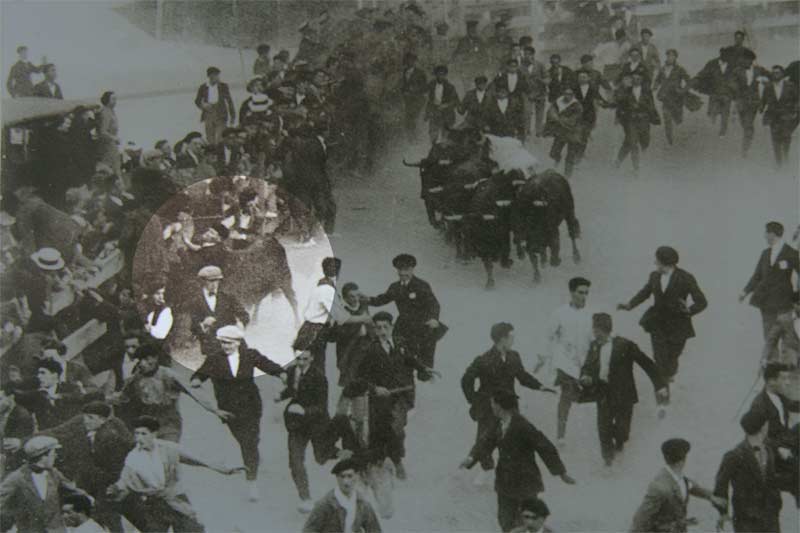
© Archivo Fernando Hualde
7th July, 1910. Francisco García Gurrea
(21 years old, Falces)
Injured at the entrance of the former Bullring (Near to the Gayarre Theatre).
Ranch: Villagodio
Until the year 2002 it was thought that the first person to be killed as a consequence of being gored during the running of the bulls in Pamplona was the young man from Sangüesa Esteban Domeño, but that year Unai Alduán Colmenares reported the identity of the first known runner who died in the running of the bulls until to date; Francisco García Gurrea.
Unai Alduán Colmenares found, by chance, a news article included in the El Pensamiento Navarro newspaper on the 18th of January 1911, in which the following was said: ” Francisco García Gurrea, 21 years old, died in this city, as a consequence of the injuries suffered in one the running of the bulls of the latest San Fermin fiestas. May he rest in peace”. Being interested in this, Unai checked whether said name was included in the list of the 13 dead people that was known until that moment, and he was surprised when he found out that it was not. He began to research and verify the information appeared in various local newspapers of the time.
The already mentioned Pensamiento Navarro, El Eco de Navarra and La Tradición Navarra, and he was able to confirm that, indeed, on the 7th of July 1910 the young man Francisco García Gurrea had been injured in the spectacular heap of people -of more than one hundred runners- just at the entrance of the former bullring which is now the Gayarre Theatre. In accordance with those newspapers, the young man was trampled by the people and as a consequence received two stitches in his ear. Apparently, those injuries resulted in tuberculosis that finally caused Francisco García’s death on the 18th of January 1911.
The fact that he died months later and the subsequent fire in the former bullring (in August 1922), in which there may have been a document explaining the medical progress of this runner, may have been two reasons for which this discovery has remained hidden for so long.

